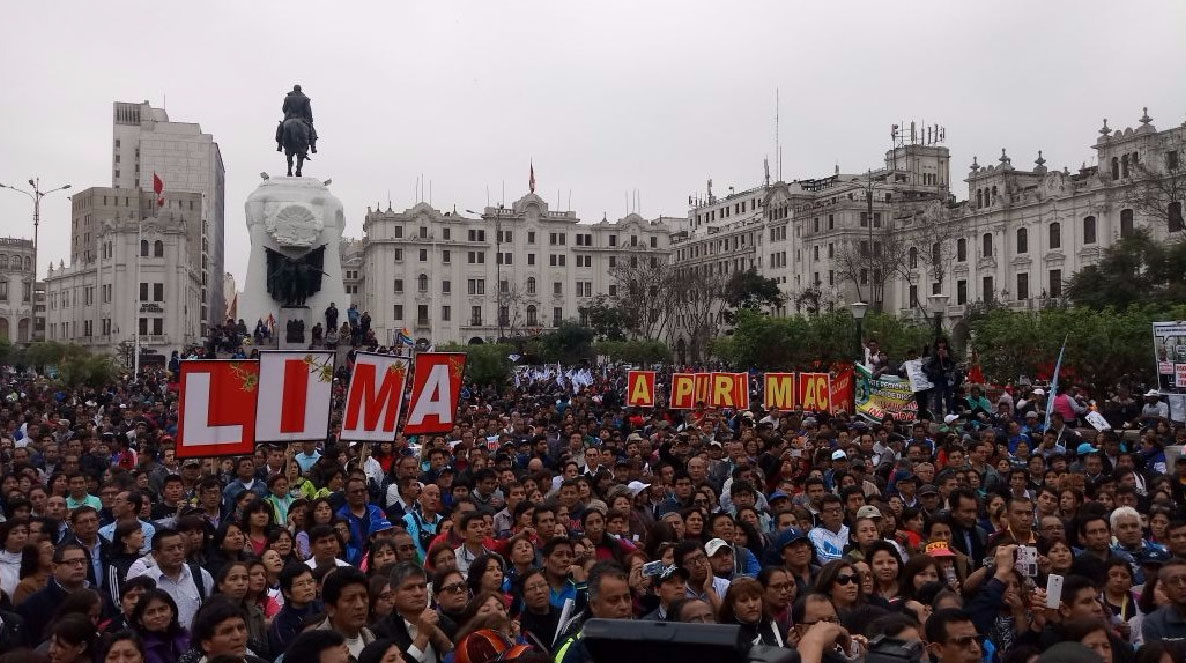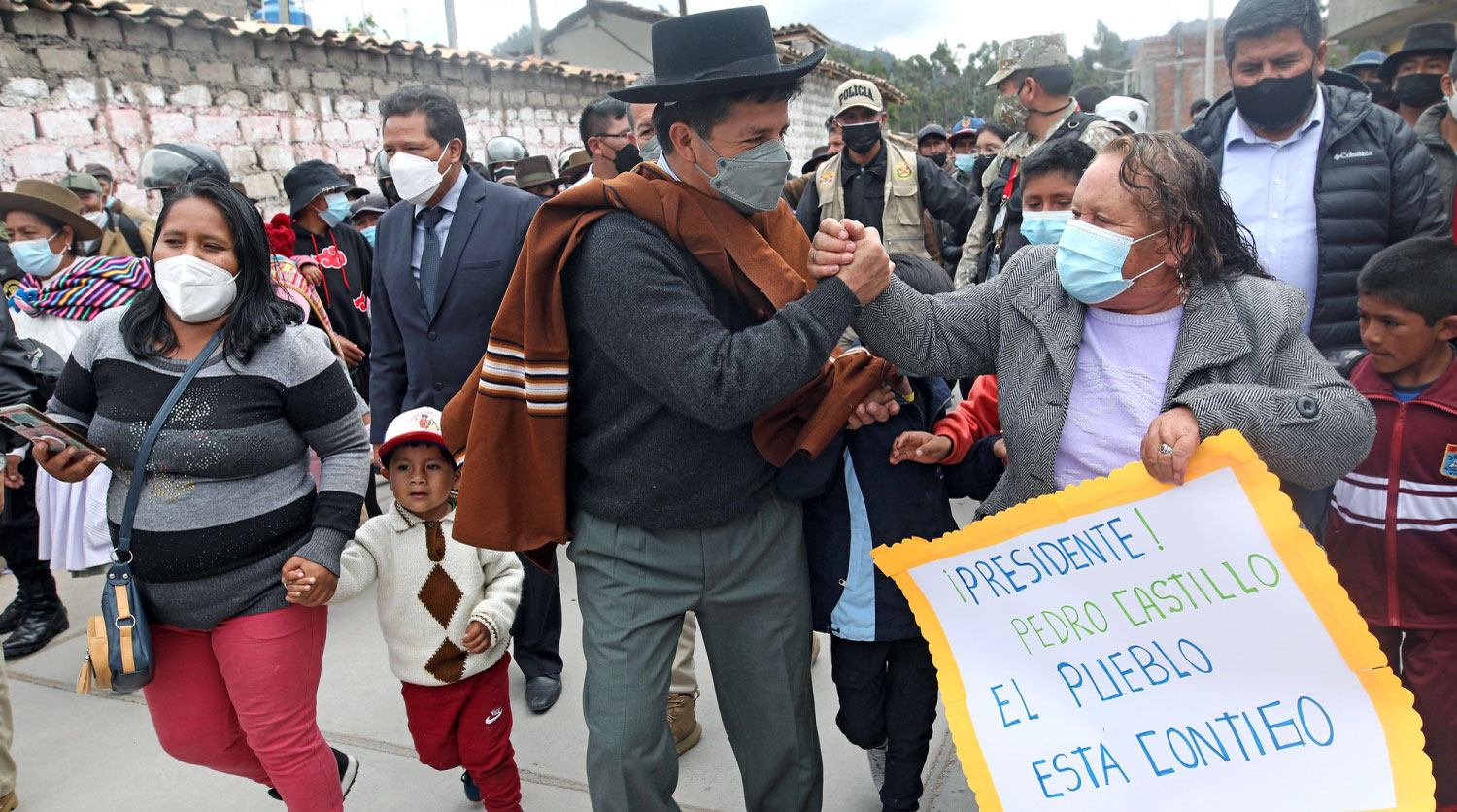The crisis we are experiencing is not new. It would seem that we had already hit rock bottom and that we could not fall any lower. However, the days go by and the misgovernment grows stronger. After five different presidents in five years, the only permanent and lasting features in Peru seem to be police repression and an economic model based on the exploitation and export of raw materials.
The crisis we are experiencing is not new. It would seem that we had already hit rock bottom and that we could not fall any lower. However, the days go by and the misgovernment grows stronger. After five different presidents in five years, the only permanent and lasting features in Peru seem to be police repression and an economic model based on the exploitation and export of raw materials.
After defeating the Fujimori dictatorship in 2000, we lived twenty years in an eventful and supposedly democratic spring. Everything looked very promising on the outside during this period: every five years we elected a president; the macroeconomic figures showed us as a middle-income country thanks to the export of raw materials; and we seemed to have an impeccable judicial process with absolute respect for the due process that tried and sentenced the former dictator Alberto Fujimori to 25 years in prison.
However, while everything seemed to be gleaming from the outside, the corrosion on the inside was growing. Since the most vulnerable people were the ones receiving the blows, in Lima, the political and economic power paid no attention to the attacks suffered in other regions of a country as vast as Peru.
Social protests against the pollution and abuse generated by extractivism increased, especially in Indigenous territories. As the socio-environmental conflicts, the criminalization of leaders and the deaths of territorial defenders increased, the State's response, government after government, followed the same script: repression, excessive use of force and the curtailment of rights.

The teachers' strike initiated the long political crisis in Peru. Photo: Pólemos

The teachers' strike initiated the long political crisis in Peru. Photo: Pólemos
Political earthquakes and the unnoticed phenomenon
Between June and September 2017, a teachers' strike paralyzed public education. At these strikes, a particular union leader became known: Pedro Castillo. Since public education does not affect neither political nor economic power, some benefits were negotiated and the strike ended. However, public education did not improve, and the Peruvian elite believed that Pedro Castillo would be forgotten.
Then, two incidents shook the political power: the Odebrecht scandal and the discovery of a criminal network of high-ranking judges and prosecutors. The first denounced how politicians from all governments criminally profited from construction companies. The second uncovered a network of judicial corruption that negotiated impunity to whoever could buy it: rapists of girls and women, murderers, drug traffickers and white-collar criminals. It triggered the beginning of the chaos.
Two incidents shook the political power: the Odebrecht scandal and the discovery of a criminal network of high-ranking judges and prosecutors.
Two incidents shook the political power: the Odebrecht scandal and the discovery of a criminal network of high-ranking judges and prosecutors.
When in 2018 it became public that the then President of the Republic, Pedro Pablo Kuczynski, had received money from Odebrecht during his term as Minister of Economy of Alejandro Toledo (2001-2006), he sought to negotiate his permanence in power by granting a pardon to Fujimori. He believed that in this way the Congress, with a pro-Fujimori majority, would not remove him from office. He was wrong. Given the magnitude of the scandal, he had to resign. His place was taken by the vice- president, Martin Vizcarra.
The new president began his term in an unprecedented way: by confronting Fujimorism. Faced with the magnitude of corruption, Vizcarra had quick reflexes and made public speeches that won the support of the population. In this struggle with Fujimorism, he even reached the point of closing the Congress. Although he achieved great popularity, the country's economic path, based on the exploitation and export of raw materials, continued along the same path.

Pedro Pablo Kuczynski had to resign due to the Odebrecht bribery scandal. His vice-president and successor, Martin Vizcarra, confronted Fujimorism and achieved high levels of support. Photo: Presidency of Peru

Kuczynski resigned due to the Odebrecht scandal. His vice- president and successor, Martin Vizcarra, confronted Fujimorism and achieved high levels of support. Photo: Presidency of Peru
From pandemic to the empty promise of economic change
With the arrival of Covid-19 in 2020, the gloss of institutionalism was no longer enough and the spiral of chaos was reinforced: the pandemic evidenced a precarious health system based on informality. After the vaccine corruption scandal, the new Congress ended up vacating Vizcarra. The leader of this process, Manuel Merino, assumed the presidency. The discontent over the removal of a president with high levels of popularity generated massive protests in Lima that ended with disproportionate police repression and the death of two young people. Merino had to resign and the presidency was occupied by Congressman Francisco Sagasti.
In the 2021 elections, there were more than 10 presidential candidates. After an atomized vote, Keiko Fujimori and Pedro Castillo (the teacher from Cajamarca who had led the 2017 strike) passed on to the secound round of votes in a presidential runoff. While Alberto Fujimori's daughter had the support of the corporate right-wing, the union leader Castillo bannered a leftist discourse against corruption that agglutinated the demands of the population, above all, of the Indigenous peoples affected by extractive companies. However, it was clear that Castillo understood neither human rights nor gender equality: he mocked transgender people and did not know what to say concerning femicides.
Castillo did not fulfill his promises to modify the economic course – the promise of a new constitution that would limit the inhuman profit of private companies, an agrarian reform, the fight against corruption and equality for all people.
Castillo's government did not keep its promises to change the economic course.
In a tight runoff, Keiko did not want to accept her defeat. She accused hundreds of polling station officials from regions far from Lima of having committed fraud. Racism exploded. The questioning of Pedro Castillo in regards to the change in the economic course was mixed with contempt and discrimination against Indigenous people. The most expensive law firms in the capital filed nullity actions, constitutional processes and all kinds of legal actions against hundreds of voting records from all over the country. The attempt to disregard the elections was unsuccessful and, after a long wait, the electoral authority proclaimed Castillo as president.
A new term began in August 2021. However, from the beginning, the Parliament sought by all means to attack and vacate the president with increasingly flimsy arguments. For its part, the Castillo government did not fulfill its promises to change the economic course – the promise of a new constitution that would limit the inhuman profit of private companies, an agrarian reform, the fight against corruption and equality for all people. Instead, Castillo has dedicated himself to responding to Congress, repeating old practices of corruption, negotiating positions in ministries and offering measures that violate human rights. In short, he forgot to govern.

Pedro Castillo defeated Keiko Fujimori in a very close ballot. While Keiko did not want to recognize her defeat, Castillo did not fulfill his reform program. Photo: ANDINA / Carla Patiño

Castillo defeated Keiko Fujimori on the ballot. While Keiko did not want to recognize her defeat, Castillo did not fulfill his reform program. Photo: ANDINA / Carla Patiño
The outbreak of the crisis
By the end of March 2022, the misgovernment and the economic crisis could not hold out any longer and protests broke out. The paralyzation of farmers and traders in several areas of the country prevented the movement of people and food. The government's response was the same formula: repression. On April 5, the same date of Fujimori's self-coup, Castillo decreed a state of emergency in Lima and, the following day, extended it to the entire road network in order to limit the protests. The repression resulted in four deaths and police shootings denounced by protesters. The government has not yet apologized and no minister has resigned in response to this incident.
While the Parliament continues to be busy absurdly attacking the Executive power, on April 22 the Government announced a Constituent Assembly to be voted by referendum in October of this year. Although the proposal does not provide urgent solutions, Castillo has managed to divert the public debate because structural and economic model change is a demand of many sectors of the citizenry.
The Constitutional Court has denied the right to prior consultation of Indigenous peoples and is in danger of being renewed with anti-rights members and has been denounced for corruption.
The institutions that should protect the rule of law and defend citizens are also at serious risk.
Meanwhile, the institutions that should protect the rule of law and defend the citizenry are also at serious risk. The Constitutional Tribunal has denied the right to prior consultation of indigenous peoples and is in danger of being renewed with members who are anti-rights and who have been denounced for embezzlement of public funds. Meanwhile, those running for office for the regional and local elections in October, are people linked to cases of corruption.
The only constant seems to be an economy based on extractivism and the repression of social protests. In the south of the country, two localities of the K'ana Indigenous people have been affected by the Las Bambas mining company and have been imposed with a decree restricting their rights. Meanwhile, from the Valley of the Apurimac, Ene and Mantaro Rivers (VRAEM), Castillo, dressed in an Amazonian Indigenous costume, encouraged visits to the villages and urged Congress to approve the proposal for a Constituent Assembly.

Despite his closeness to the popular classes in the regions of Peru, Pedro Castillo has not fulfilled his agenda of reforms to distribute the wealth that is concentrated in Lima. Photo: Presidency de Peru

Despite his closeness to the popular classes in the regions of Peru, Pedro Castillo has not fulfilled his agenda of reforms to distribute the wealth that is concentrated in Lima. Photo: Presidency de Peru
A country in the search of a way out
While the President still has not announced concrete actions to alleviate the crisis, there has just been a case of police repression of the population of Cotabambas. Among the wounded and arrested is Rosa Paniura Vargas, a 60-year-old woman who was hospitalized with a serious eye injury and as a result is at risk of losing her sight.
The political class continues to dig a bottomless pit, with no glimpse of a way out and no leadership to unite the multiple demands of the population. The truth is that if these protests did not explode, the government and Congress would have continued in their infinate game of boycotting each other (which has been going on for five years now), of attacking each other and, at the same time, maintaining the status quo.
This vicious circle has only been broken thanks to the protests in the regions. If these demands could be articulated, it would be possible to start demanding from this government some order, direction and concrete actions to face an economic crisis that is growing by leaps and bounds. As long as they do not do so, we will continue to wait for a “messiah” and continue in the same game of attacks between the Government and the Parliament.
